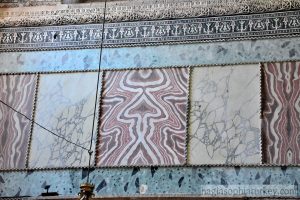Quick Guide 33: Marble Panels of Hagia Sophia
Table of Contents
 Marble panels of Hagia Sophia have all been made with beautiful marble brought from different parts of the Roman Empire. Some panels have been sliced into two with silk yarn to obtain symmetrical designs.
Marble panels of Hagia Sophia have all been made with beautiful marble brought from different parts of the Roman Empire. Some panels have been sliced into two with silk yarn to obtain symmetrical designs.
Marble Panels of Hagia Sophia
The Hagia Sophia, located in Istanbul, Turkey, is a historic architectural marvel that has undergone various transformations throughout its long history. It has served as both a cathedral and a mosque and is now a museum. The marble panels of Hagia Sophia are an integral part of its interior decoration and have contributed to its grandeur and historical significance.
- Marble Revetment: The interior of the Hagia Sophia is adorned with exquisite marble revetment, which is essentially a covering or facing of marble slabs on the walls. These marble panels were used to decorate the interior surfaces of the building, including the walls and columns. They are notable for their intricate patterns, designs, and the variety of marble types used.
- Proconnesian Marble: One of the most renowned types of marble used in the Hagia Sophia is Proconnesian marble, which is known for its fine quality and was often used in various historical buildings throughout the Byzantine Empire. It is characterized by its white or off-white color and was highly valued for its aesthetic appeal.
- Geometric and Floral Patterns: The marble panels in Hagia Sophia feature a combination of geometric and floral patterns. These patterns are beautifully carved or etched onto the marble surfaces and create a stunning visual effect when combined with the building’s unique architectural features, such as the massive dome and the use of natural light.
- Inscriptions and Decorative Elements: In addition to the decorative patterns, the marble panels may also include inscriptions in Greek or Arabic script, depending on the period when they were added or modified. These inscriptions often contain religious verses, dedicatory statements, or historical information.
- Restorations and Alterations: Over the centuries, Hagia Sophia has undergone several renovations and alterations due to changes in religious affiliations and architectural styles. As a result, some of the original marble panels may have been replaced or modified during these renovations.
- Accessibility: While some of the marble panels are located at eye level and can be easily observed, others may be higher up on the walls or concealed behind other decorative elements. Visitors to Hagia Sophia can admire these panels as part of their exploration of this historic structure.
The marble panels of Hagia Sophia are not only a testament to the craftsmanship of their time but also serve as a reflection of the cultural and religious history of the region. They contribute to the overall beauty and significance of this iconic building, which has played a central role in the history of both the Byzantine and Ottoman Empires.
You can also watch our Virtual Tour of Hagia Sophia. For more information about Serif Yenen and his tours, please visit www.serifyenen.com
